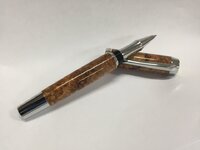law_kid
Member
I have been having trouble with scratches in my CA finishes of late, and I am not sure why. I have not changed my technique any, but I've noticed when using darker woods that there are still visible scratches, even after using the sanding pads, acrylic scratch remover paste, and buffing steps.
The pads I have been using are Barry Gross' acrylic finishing pads, which have heretofore given me good results. Is it possible that there are defective pads with some improper grits embedded in the pads? Has anyone else had trouble with these pads? I am at my wits' end.
Thanks.
The pads I have been using are Barry Gross' acrylic finishing pads, which have heretofore given me good results. Is it possible that there are defective pads with some improper grits embedded in the pads? Has anyone else had trouble with these pads? I am at my wits' end.
Thanks.

